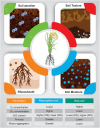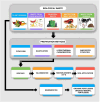The role of biochar in enhancing soil health & interactions with rhizosphere properties and enzyme activities in organic fertilizer substitution
- PMID: 40584857
- PMCID: PMC12202221
- DOI: 10.3389/fpls.2025.1595208
The role of biochar in enhancing soil health & interactions with rhizosphere properties and enzyme activities in organic fertilizer substitution
Abstract
Modern agriculture faces a dual challenge: sustainable crop production and reducing the environmental impacts of excessive chemical fertilizers use, which leads to soil degradation, nutrient leaching and declining microbial diversity. Addressing these issues, biochar, a carbon-rich by product of pyrolysis, has emerged as a promising soil amendment due to its ability to enhance soil health, support nutrient cycling, and contribute to climate mitigation. However, its interactive effects with rhizosphere dynamics and soil enzymatic process, particularly when used with organic fertilizers, remain insufficiently explored. This review compiles current knowledge on the short-term and long-term impacts of biochar, particularly in combination with organic fertilizers, on rhizosphere properties, enzyme activities, and nutrient dynamics. In the short term, biochar improves soil structure, water retention, and microbial activity, while reducing nutrient leaching and increasing enzymatic functions. Over the long term, it facilitates carbon sequestration, stabilizes soil organic matter (SOM), and ensures nutrient availability, thereby promoting sustainable crop production. The synergistic application of biochar with organic amendments, such as compost and crop residues, further enhances soil fertility and ecosystem services. Despite its numerous benefits, the adoption of biochar on a larger scale is hindered by challenges related to cost-effectiveness, production consistency, and logistical constraints in diverse agricultural systems. Addressing knowledge gaps related to optimal feedstock selection, pyrolysis conditions, and application rates is essential for maximizing biochar's potential. By integrating biochar into sustainable agricultural practices, farmers can enhance soil productivity, reduce environmental impacts, and contribute to climate change mitigation. A strategic and evidence-based implementation of biochar technologies holds promise for achieving long-term sustainability and food security goals.
Keywords: biochar; carbon sequestration; nutrient cycling; organic fertilizers; sustainable agriculture.
Copyright © 2025 Ali, Jabeen, Chachar, Chachar, Ahmed, Ahmed, Laghari, Sahito, Farruhbek and Yang.
Conflict of interest statement
The authors declare that the research was conducted in the absence of any commercial or financial relationships that could be construed as a potential conflict of interest.
Figures



Similar articles
-
Enhancing soil carbon sequestration in jasmine gardens: Differential effects of straw and biochar on mineral-associated and particulate organic carbon.J Environ Manage. 2025 Aug;389:126282. doi: 10.1016/j.jenvman.2025.126282. Epub 2025 Jun 19. J Environ Manage. 2025. PMID: 40540918
-
A systematic review of biochar research, with a focus on its stability in situ and its promise as a climate mitigation strategy.PLoS One. 2013 Sep 30;8(9):e75932. doi: 10.1371/journal.pone.0075932. eCollection 2013. PLoS One. 2013. PMID: 24098746 Free PMC article.
-
Nitrogen flow in livestock waste system towards an efficient circular economy in agriculture.Waste Manag Res. 2023 Mar;41(3):701-712. doi: 10.1177/0734242X221123484. Epub 2022 Sep 21. Waste Manag Res. 2023. PMID: 36129010
-
Enhancing soil health through balanced fertilization: a pathway to sustainable agriculture and food security.Front Microbiol. 2025 Apr 28;16:1536524. doi: 10.3389/fmicb.2025.1536524. eCollection 2025. Front Microbiol. 2025. PMID: 40356641 Free PMC article. Review.
-
[Effect of Biochar-based Fertilizer Application on Soil Enzyme Activity, Fungal Community, and Crop Yield in Winter Wheat-Summer Maize Rotation Farmland].Huan Jing Ke Xue. 2025 Jun 8;46(6):3965-3974. doi: 10.13227/j.hjkx.202405297. Huan Jing Ke Xue. 2025. PMID: 40582831 Chinese.
References
-
- Adhikari S., Timms W., Mahmud M. P. (2022). Optimising water holding capacity and hydrophobicity of biochar for soil amendment–a review. Sci. Total Environ. 851, 158043. - PubMed
-
- Afshar M., Mofatteh S. (2024). Biochar for a sustainable future: Environmentally friendly production and diverse applications. Results Eng. 23, 102433. doi: 10.1016/J.RINENG.2024.102433 - DOI
-
- Ahmed N., Zhang B., Chachar Z., Li J., Xiao G., Wang Q., et al. (2024). Micronutrients and their effects on Horticultural crop quality, productivity and sustainability. Scientia Hortic. 323. doi: 10.1016/j.scienta.2023.112512 - DOI
-
- Akhtyamova A., Galieva G., Vasserman D., Selivanovskaya S. (2019). Influence of soil application of biochar, a fertilizer, a biopreparation and a pesticide on the functional characteristics of soil microbial community. Int. Multidiscip. Sci. GeoConference Surveying Geology Min. Ecol. Management SGEM 19. doi: 10.5593/sgem2019/5.2/S20.061 - DOI
Publication types
LinkOut - more resources
Full Text Sources

